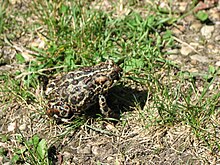
The American toad is a common species of toad found throughout Canada and the eastern United States. It is divided into three subspecies: the eastern American toad, the dwarf American toad and the rare Hudson Bay toad. Recent taxonomic treatments place this species in the genus Anaxyrus instead of Bufo.

The Houston toad, formerly Bufo houstonensis, is an endangered species of amphibian that is endemic to Texas in the United States. This toad was discovered in the late 1940s and named in 1953. It was among the first amphibians added to the United States List of Endangered Native Fish and Wildlife and is currently protected by the Endangered Species Act of 1973 as an endangered species. The Houston toad was placed as "endangered" on the IUCN Red List of Threatened Species from 1986 to 2022, and has worsened to "critically endangered" since then, with fewer than 250 mature individuals believed to remain in the wild as of 2021. Their kind is threatened every day as they continue to suffer from a loss of habitat, extreme drought, and massive wildfires. Their typical life expectancy is at least 3 years but it may exceed this number.
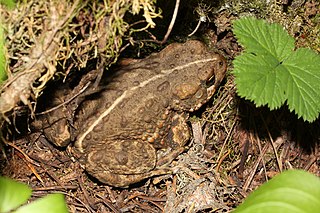
The western toad is a large toad species, between 5.6 and 13 cm long, native to western North America. A. boreas is frequently encountered during the wet season on roads, or near water at other times. It can jump a considerable distance for a toad. Breeding occurs between March and July in mountainous areas, and as early as January in lower-elevation regions. The female lays up to 17,000 eggs stuck together in strings that adhere to vegetation and other objects along water edges.

The red-spotted toad, formerly Bufo punctatus, is a toad in the family Bufonidae found in the southwestern United States and northwestern Mexico.

The Wyoming toad, also known commonly as Baxter's toad, is a species of toad in the family Bufonidae. The Wyoming toad is an extremely rare amphibian that exists only in captivity and within Mortenson Lake National Wildlife Refuge in Wyoming in the United States. The Wyoming toad was listed as an endangered species in 1984, and listed as extinct in the wild since 1991. As with black-footed ferrets at the Tom Thorne and Beth Williams Wildlife Research Center at Sybille in Wheatland, Wyoming, the effort to save the Wyoming toad has been a cooperative effort among state and federal agencies and private landowners. The Wyoming toad was common from the 1950s through the early 1970s, but its distribution was limited to the Laramie Basin in Albany County. The population crashed around 1975 and was extremely low by 1980. The Wyoming toad was federally listed as endangered in January 1984. To prevent extinction, a captive-breeding program began in 1989 at the Thorne Williams Unit that produced enough offspring in its first few years to supply seven zoos, and in 1998 the Saratoga National Fish Hatchery received captive-breeding stock. Nearly 46,000 offspring were produced at the Thorne Williams Unit from 1995 until 2006, when the remaining captive stock was moved to the Red Buttes Environmental Biology Laboratory south of Laramie, and then released back into the wild. Before the sharp declines occurred, this toad had been originally classified as Bufo hemiophrys baxteri, a subspecies of the Canadian toad, by Kenneth Raymond Porter in 1968.

The southern toad is a true toad native to the southeastern United States, from eastern Louisiana and southeastern Virginia south to Florida. It often lives in areas with sandy soils. It is nocturnal and spends the day in a burrow. Its coloring is usually brown but can be red, gray, or black. It is approximately 8 cm (3 inches) long.

The Texas toad is a species of medium-sized toad that occurs in the southern United States and northern Mexico. It breeds in temporary water pools after heavy rains.
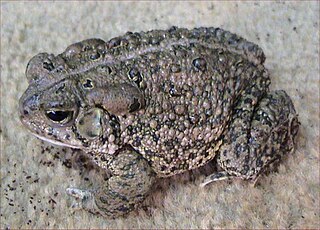
Woodhouse's toad is a medium-sized true toad native to the United States and Mexico. There are three recognized subspecies. A. woodhousii tends to hybridize with Anaxyrus americanus where their ranges overlap.

The boreal toad is the nominate subspecies of the western toad. They are commonly found in the Southern Rocky Mountains, and their population has recently been on the decline due to an emerging amphibian disease, chytrid fungus. The boreal toad is currently listed as an endangered species by Colorado and New Mexico. It is known in Colorado as the only alpine species of toad.
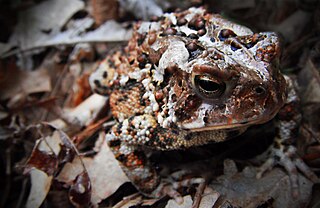
Fowler's toad is a species of toad in the family Bufonidae. The species is native to North America, where it occurs in much of the eastern United States and parts of adjacent Canada. It was previously considered a subspecies of Woodhouse's toad.

The Great Plains toad is a relatively large species of true toad native to central North America.
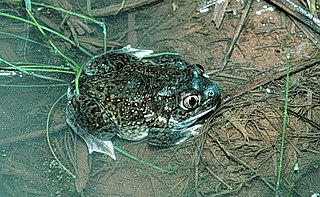
The plains spadefoot toad is a species of American spadefoot toad which ranges from southwestern Canada, throughout the Great Plains of the western United States, and into northern Mexico. Like other species of spadefoot toads, they get their name from a spade-like projection on their hind legs which allows them to dig into sandy soils. Their name, in part, comes from their keratinized metatarsals, which are wide instead of "sickle shaped". The species name translates as buzzing leaf shaped. This refers to the species' distinguishing features; its buzzing mating call, and its leaf-shaped digging metatarsals. It was first described by Cope in 1863.

The Yosemite toad is a species of true toad in the family Bufonidae. Endemic to the Sierra Nevada of California, the species ranges from the Alpine County to Fresno County. Yosemite toads are only found in the montane to subalpine elevational zone of 1,950–3,445 m (6,398–11,302 ft) asl. The Yosemite toad is similar to the nearby western toad, but in many ways adapted to a high elevation lifestyle. It was initially described during the Grinnell Survey of California, by an undergraduate student of Joseph Grinnell named Charles Camp.
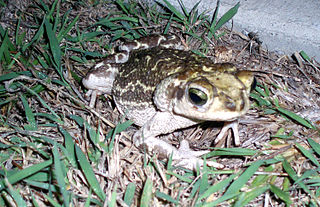
The Cuban small-eared toad, also known as the Cuban toad or Cope's Caribbean toad, is a species of toad in the family Bufonidae that is endemic to Cuba including Isla de Juventud.
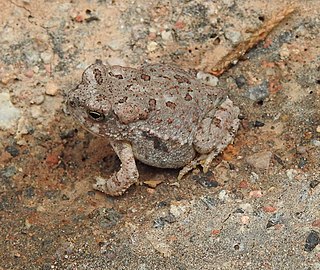
The Arizona toad is a species of toad in the family Bufonidae. It is endemic to the south-western United States, where its natural habitats are temperate lowland forests, rivers and streams, swamps, freshwater marshes, freshwater springs, ponds, open excavations, irrigated land, and seasonally flooded agricultural land.

The oak toad is a species of toad in the family Bufonidae. It is endemic to the coastal regions of southeastern United States. It is regarded as the smallest species of toad in North America, with a length of 19 to 33 mm.
The Sonoran green toad is a species of toad in the family Bufonidae. It is found in northern Mexico and the southwestern United States.

The Great Basin spadefoot is an amphibian in the family Scaphiopodidae. It is 3.8 to 6.3 centimetres long and is usually colored gray, olive or brown. Great Basin spadefoot toads have adapted to life in dry habitats. They use the hard, keratinized spade on each foot to dig a burrow, where they spend long periods during cold and dry weather. They are opportunistic hunters and will eat anything they can subdue. While their tadpoles have numerous predators, adults are able to produce skin secretions that deter enemies.
The Hudson Bay toad is a rare subspecies of the American toad. As suggested by its name, it is found in the Hudson Bay region in Ontario and Quebec, Canada. However, the status of Anaxyrus americanus subspecies is unclear, and Anaxyrus americanus copei is not listed in the 2012 edition of the "Scientific and Standard English Names of Amphibians and Reptiles of North America North of Mexico".
